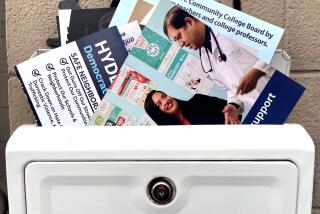You’ve Got Ads: E-Marketing Is Thriving
NEW YORK — E-mail advertisements, a time-eating curse for consumers and an overload nightmare for computer-system administrators, are likely to multiply in the next several years--and it’s all your fault.
The e-mails keep coming because consumers keep following the links to other sites that they contain. Whether recipients click because they are interested in the offered deal, are curious or just want to send anti-advertising hate mail, they’re counted as responding to the e-mail.
More is on the way. At the National Retail Federation convention last week in New York, a panel of expert electronic mailbox stuffers explained to hundreds of aspiring Internet marketers how and why e-mail ads work.
Once the newcomers venture online, consumers are likely to be blanketed with even more junk e-mail. And while the experts caution against blindly e-mailing masses of people--which is illegal in many cases--the experts recommend targeted group mailings because they can be personalized, track a consumer’s preferences and cost a fraction of an old-fashioned direct-mail campaign.
With no printing or paper costs and no postage, the biggest expense of e-mail marketing is usually in gathering a list of recipients. How the retailers do that is about as controversial as the resulting e-mail ads.
“The cost of e-mail marketing isn’t doing it; it’s losing a customer if you don’t do it right,” said moderator Ray Kaupp, vice president of marketing for consulting group Digital Impact.
Whether there are ways of doing it right, however, might be up for debate.
“Consumers told us loud and clear that they don’t want banner ads and they don’t want e-mail ads,” said Stephanie Shern, Ernst & Young’s director of retail and consumer products.
In a survey, Ernst & Young found that e-mail ad solicitations were at the bottom of the list of why consumers click on a site--they usually go to someplace listed in their bookmarks or type in the obvious address of a known brand, such as “Gap.com.”
But even at the bottom of the list, E&Y; found that 14% of U.S. consumers will visit a Web site listed in an unsolicited e-mail. With estimates of 100 million e-mail users, even a small response sounds good to those with something to sell.
The panel of Web-savvy sellers said that what makes e-mail marketing effective is personalization and a tight time frame. Retailers can react quickly to competitors’ pricing moves and immediately alert customers. The response also is swift; home entertainment seller Hifi.com found that 85% of the responses to its e-mail pitches come within 48 hours.
Retailers also can learn a lot from who clicks where and send more-tailored advertisements, the panelists said.
If a shopper once clicked on a yellow sweater, a retailer can e-mail that person when the sweater goes on sale or suggest a matching pair of pants; if the respondent likes purple, the site can rearrange the home page so that it always features the company’s purple offerings.
The expert e-mailers, which included representatives from Sharper Image, Fogdog Sports and Hifi.com, suggested creative ways to obtain e-mail addresses: the promise of a coupon or a gift, such as a baseball cap with the company’s logo.
But they also cautioned against some of e-mail advertising’s most egregious practices--even featuring an NRF attorney on the panel to clarify the e-mail legalities.
They advised against using what one online marketer called “the four-letter ‘S’ word”--spam--the unsolicited bulk e-mail that often leads unsuspecting recipients to pornography sites or get-rich-quick schemes.
Instead, many online and traditional retailers say they use “opt-in” systems for generating their mailing lists, meaning that only those who specifically ask to be put on the mailing list get the mail.
However, some retailers might define “opt in” differently from their customers. Just like catalogs that come to home mailboxes, e-mailing lists are sometimes created by culling names and addresses of consumers who buy online, register on a Web site or patronize a retailer’s online partner.
So some e-mails from legitimate retailers, raving about discounts or special products, might be barely distinguishable from spam to many consumers.
Annoyed as many e-mail users are by the ads, they still respond to them three to 10 times more than they do to banner advertisements that flash across the top of computer screens, according to Digital Impact.
Note-taking attendees to the seminar were advised to write to-the-point messages, clearly detail “opt-out” procedures for those who don’t want to receive the announcements and resist the temptation to e-mail too often.
“The more you talk, the less people listen,” said Thomas Abert, the director of business development for Hifi.com. “Whatever your offer, it’s not so great that you need to tell them three times a week.”
And the panel urged the retailers to enhance their mailings with usable information, such as Amazon.com’s weekly book reviews, which are complete with links to buy the books, of course.
Follow these simple rules and consumers will click, even if they quietly complain.
“I complain about e-mails, but it’s a part of my life and I think it’s human nature to complain to some extent,” Abert said. “People do not hesitate to communicate via e-mail if they’re mad at you.”
Soon those consumers will have something else to communicate. Along with the ability to quickly download music and video comes the ability to obtain a more familiar type of ad: television-like commercials, right there in your in box.
More to Read
Inside the business of entertainment
The Wide Shot brings you news, analysis and insights on everything from streaming wars to production — and what it all means for the future.
You may occasionally receive promotional content from the Los Angeles Times.










